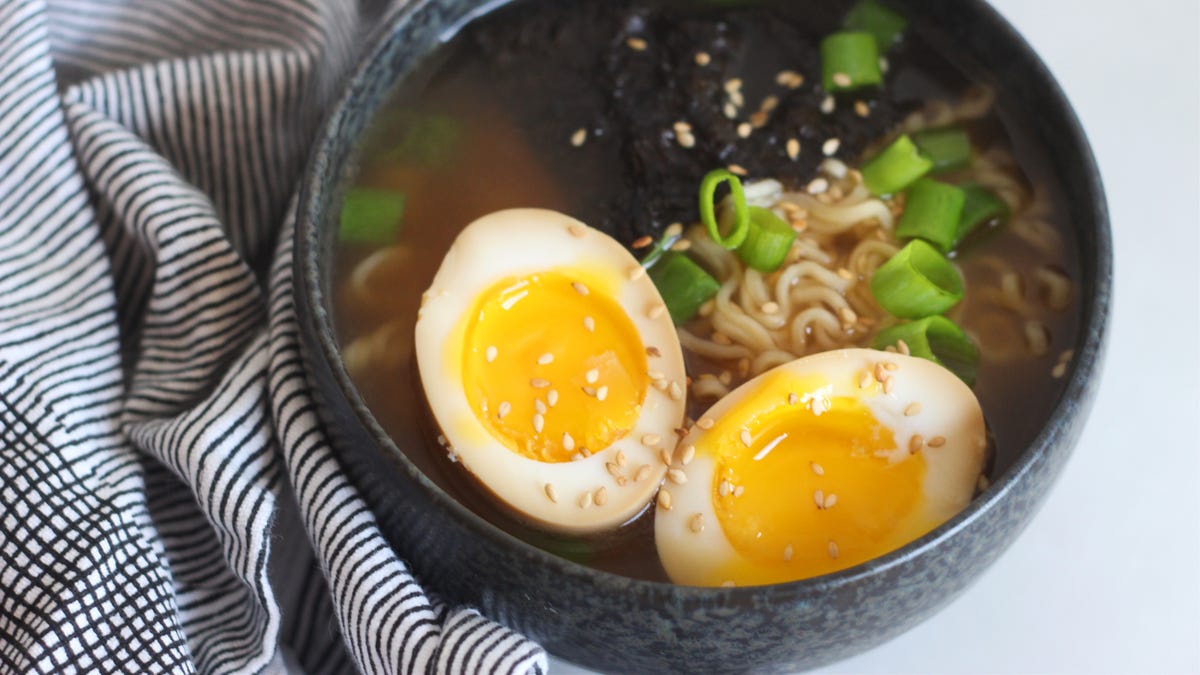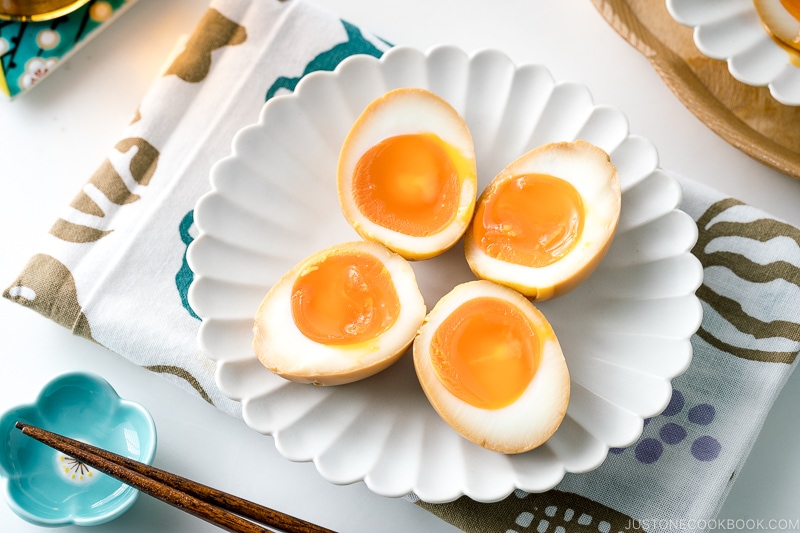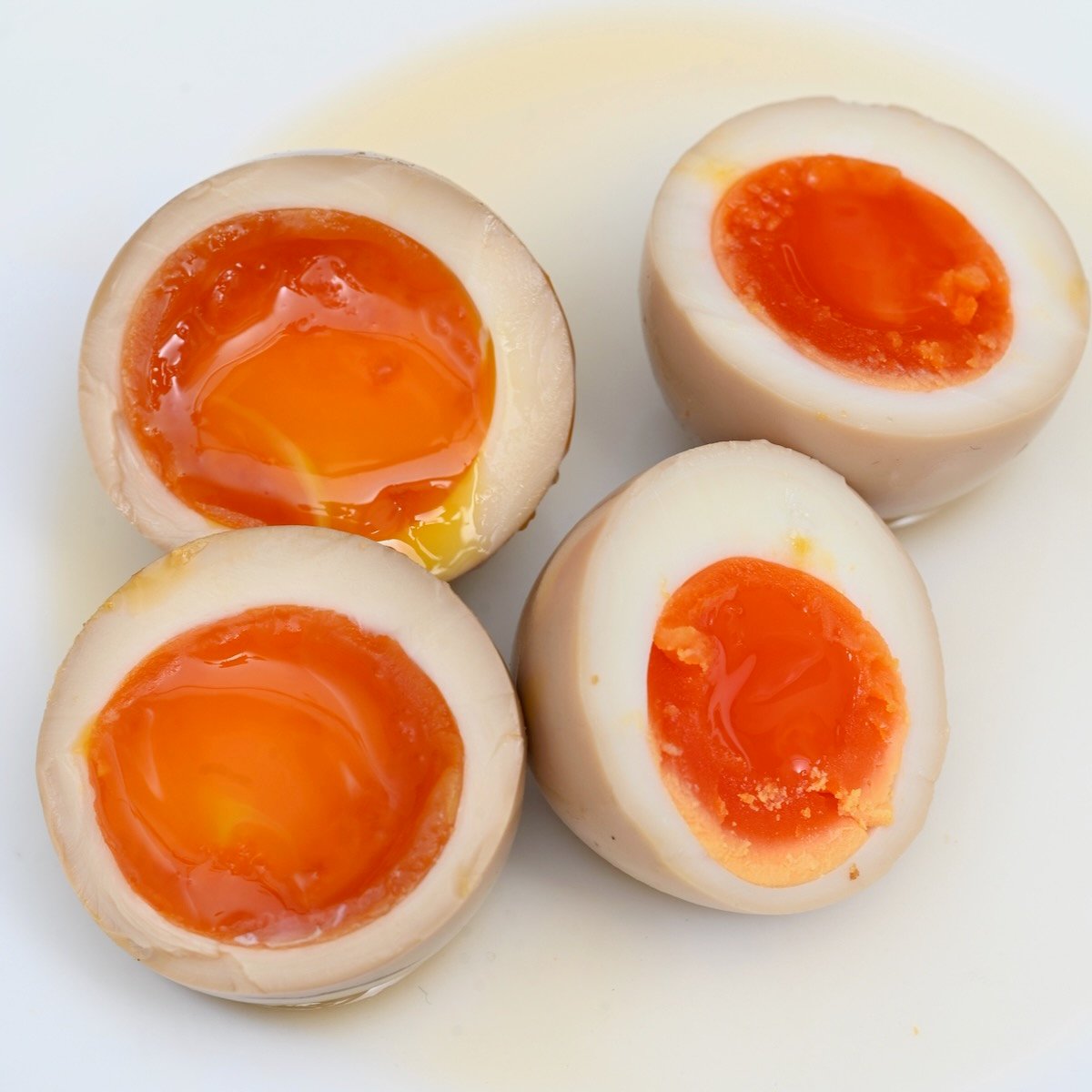Ramen eggs are soy sauce marinated eggs that are soft boiled for a runny, jammy yolk. Theyre also called shoyu eggs, soy sauce eggs, or soy marinated eggs. In Japan theyre called ajitama or ajitsuke tamago (味付け玉子) and are often served atop a bowl of ramen.
Ramen eggs are delicious soft boiled eggs that are marinated in a soy sauce and mirin mixture. No bowl of ramen is complete without these eggs in my opinion. They can have a soft, runny yolk, or a gelatinous jammy yolk according to your preference.
Ajitama has a savory, umami taste, and depending on how long theyve been marinating for, theyll have a stronger soy sauce flavor.
Ramen eggs are also known as soy sauce eggs, soy marinated eggs, or shoyu eggs. In Japan they go by ajitama which is a portmanteau of ajitsuke tamago (味付け玉子) which translates to seasoned eggs.
These soy sauce eggs also make a great snack and can be added to salads, rice bowl, or other noodles. Ramen eggs are low carb, naturally keto friendly, and high in protein.

Ramen Eggs – Soy Sauce Marinated Eggs

Ramen eggs are soy sauce marinated eggs that are soft boiled for a runny, jammy yolk. They’re also called shoyu eggs, soy sauce eggs, or soy marinated eggs. In Japan they’re called ajitama or ajitsuke tamago and is often served atop a bowl of ramen.
Prep: 3min
Total: 10min
Serving Size: 1 serving
Nutrition Facts: calories 81 kcal, Carbohydrate 4 g, Protein 6 g, Fat 4 g, Saturated Fat 1 g, Trans Fat 1 g, Cholesterol 164 mg, Sodium 630 mg, Fiber 1 g, Sugar 2 g, unSaturated Fat 3 g, servingSize 1 serving
Ingredients:
- 6 eggs
- 1 Tablespoon vinegar (for easy peeling)
- ½ cup water or stock
- 5 Tablespoons soy sauce
- 4 Tablespoons mirin (see Note 1 for substitutions)
- 2 teaspoons dark soy sauce ((optional for deeper color))
Instruction:
- Peel eggs: After the timer is up, place the eggs in an ice bath to stop cooking. Once cooled, crack the shell all over and carefully peel by inserting a spoon between the egg and shell.
- Serve: Cut in half and place on top of ramen noodles or rice bowls. Enjoy!
Ramen Eggs (Ajitsuke Tamago)

Ramen Eggs (Ajitsuke Tamago or Ajitama) are delicious as a topping for ramen or enjoyed as a snack. Read on to learn how to make these flavorful Japanese soft-boiled eggs at home.
Prep: 5min
Total: 495min
Yield: 4
Serving Size: 1 serving
Nutrition Facts: calories 90 kcal, Carbohydrate 2 g, Protein 7 g, Fat 5 g, Saturated Fat 2 g, Trans Fat 1 g, Cholesterol 186 mg, Sodium 311 mg, Sugar 2 g, unSaturated Fat 3 g, servingSize 1 serving
Ingredients:
- 4 large eggs (50 g each w/o shell) ((refrigerated until step 3; Use slightly older eggs, which are much easier to peel))
- 4 Tbsp soy sauce
- 4 Tbsp mirin
- 4 Tbsp sake ((or water))
- 1 tsp sugar
Instruction:
- {‘@type’: ‘HowToStep’, ‘text’: ‘Gather all the ingredients.’, ‘name’: ‘Gather all the ingredients.’, ‘url’: ‘https://www.justonecookbook.com/ramen-egg/#wprm-recipe-58361-step-0-0’, ‘image’: ‘https://www.justonecookbook.com/wp-content/uploads/2021/09/Ramen-Eggs-Ingredients.jpg’}
- {‘@type’: ‘HowToSection’, ‘name’: ‘To Make the Marinade’, ‘itemListElement’: [{‘@type’: ‘HowToStep’, ‘text’: ‘In a small saucepan, combine all the ingredients for the marinade.’, ‘name’: ‘In a small saucepan, combine all the ingredients for the marinade.’, ‘url’: ‘https://www.justonecookbook.com/ramen-egg/#wprm-recipe-58361-step-1-0’, ‘image’: ‘https://www.justonecookbook.com/wp-content/uploads/2021/09/Ramen-Egg-1.jpg’}, {‘@type’: ‘HowToStep’, ‘text’: ‘Bring it to a boil and whisk it a few times to let the sugar dissolve completely. Once boiling, lower the heat and simmer for 1 minute. Turn off the heat. Set aside to cool completely.’, ‘name’: ‘Bring it to a boil and whisk it a few times to let the sugar dissolve completely. Once boiling, lower the heat and simmer for 1 minute. Turn off the heat. Set aside to cool completely.’, ‘url’: ‘https://www.justonecookbook.com/ramen-egg/#wprm-recipe-58361-step-1-1’, ‘image’: ‘https://www.justonecookbook.com/wp-content/uploads/2021/09/Ramen-Egg-2.jpg’}]}
- {‘@type’: ‘HowToSection’, ‘name’: ‘To Make the Soft-Boiled Eggs’, ‘itemListElement’: [{‘@type’: ‘HowToStep’, ‘text’: ‘Add 4 cups (1L) water to a medium saucepan and bring it to a boil. There should be enough water to cover the eggs by at least 1 inch (2.5 cm). Once fully boiling (not a gentle, but a full boil), take out the eggs from the refrigerator and carefully and gently lower one egg at a time into the boiling water with a mesh strainer/skimmer or a ladle. When you add the first egg, set a 7-minute timer. You can cook them 6 to 6½ minutes for a runny egg yolk and 8 to 9 minutes for a custard-like egg yolk.’, ‘name’: ‘Add 4 cups (1L) water to a medium saucepan and bring it to a boil. There should be enough water to cover the eggs by at least 1 inch (2.5 cm). Once fully boiling (not a gentle, but a full boil), take out the eggs from the refrigerator and carefully and gently lower one egg at a time into the boiling water with a mesh strainer/skimmer or a ladle. When you add the first egg, set a 7-minute timer. You can cook them 6 to 6½ minutes for a runny egg yolk and 8 to 9 minutes for a custard-like egg yolk.’, ‘url’: ‘https://www.justonecookbook.com/ramen-egg/#wprm-recipe-58361-step-2-0’, ‘image’: ‘https://www.justonecookbook.com/wp-content/uploads/2021/09/Ramen-Egg-3.jpg’}, {‘@type’: ‘HowToStep’, ‘text’: ‘Lower the heat to maintain a gentle boil. Make sure the water is simmering, but not bubbling so strong that the eggs bounce around. If you want your egg yolks to be in the center, gently rotate the eggs with chopsticks once in a while for the first 3 minutes.’, ‘name’: ‘Lower the heat to maintain a gentle boil. Make sure the water is simmering, but not bubbling so strong that the eggs bounce around. If you want your egg yolks to be in the center, gently rotate the eggs with chopsticks once in a while for the first 3 minutes.’, ‘url’: ‘https://www.justonecookbook.com/ramen-egg/#wprm-recipe-58361-step-2-1’, ‘image’: ‘https://www.justonecookbook.com/wp-content/uploads/2021/09/Ramen-Egg-4.jpg’}, {‘@type’: ‘HowToStep’, ‘text’: ‘After 7 minutes, immediately take out the eggs and shock them in an iced water for 15 minutes.’, ‘name’: ‘After 7 minutes, immediately take out the eggs and shock them in an iced water for 15 minutes.’, ‘url’: ‘https://www.justonecookbook.com/ramen-egg/#wprm-recipe-58361-step-2-2’, ‘image’: ‘https://www.justonecookbook.com/wp-content/uploads/2021/09/Ramen-Egg-5.jpg’}, {‘@type’: ‘HowToStep’, ‘text’: ‘Once the eggs are completely cool, gently crack the wide bottom end of the egg and start peeling the shell vertically toward the pointy top. Dip the egg in the iced water a few times to help with the peeling. Once you peel one section vertically, the rest of the shell comes off easily.’, ‘name’: ‘Once the eggs are completely cool, gently crack the wide bottom end of the egg and start peeling the shell vertically toward the pointy top. Dip the egg in the iced water a few times to help with the peeling. Once you peel one section vertically, the rest of the shell comes off easily.’, ‘url’: ‘https://www.justonecookbook.com/ramen-egg/#wprm-recipe-58361-step-2-3’, ‘image’: ‘https://www.justonecookbook.com/wp-content/uploads/2021/09/Ramen-Egg-6.jpg’}]}
- {‘@type’: ‘HowToSection’, ‘name’: ‘To Marinate the Eggs’, ‘itemListElement’: [{‘@type’: ‘HowToStep’, ‘text’: ‘Place the eggs in a plastic bag and add the marinade to the bag. Why am I recommending a plastic bag? With a plastic bag, we don’t have to use a lot of marinade to submerge the eggs. This marinade is used only one time for food safety reasons, so it’s most economical to prepare no more than the amount you need. If you use a container instead of a bag, it requires more marinade to submerge the eggs.’, ‘name’: ‘Place the eggs in a plastic bag and add the marinade to the bag. Why am I recommending a plastic bag? With a plastic bag, we don’t have to use a lot of marinade to submerge the eggs. This marinade is used only one time for food safety reasons, so it’s most economical to prepare no more than the amount you need. If you use a container instead of a bag, it requires more marinade to submerge the eggs.’, ‘url’: ‘https://www.justonecookbook.com/ramen-egg/#wprm-recipe-58361-step-3-0’, ‘image’: ‘https://www.justonecookbook.com/wp-content/uploads/2021/09/Ramen-Egg-7.jpg’}, {‘@type’: ‘HowToStep’, ‘text’: ‘Remove the air from the bag and use a clip or rubber band to seal the bag right above the eggs. This way, the eggs are completely submerged in the marinade. Refrigerate for 8 hours or overnight. You can rotate the eggs occasionally if you like.’, ‘name’: ‘Remove the air from the bag and use a clip or rubber band to seal the bag right above the eggs. This way, the eggs are completely submerged in the marinade. Refrigerate for 8 hours or overnight. You can rotate the eggs occasionally if you like.’, ‘url’: ‘https://www.justonecookbook.com/ramen-egg/#wprm-recipe-58361-step-3-1’, ‘image’: ‘https://www.justonecookbook.com/wp-content/uploads/2021/09/Ramen-Egg-8.jpg’}]}
- {‘@type’: ‘HowToSection’, ‘name’: ‘To Serve’, ‘itemListElement’: [{‘@type’: ‘HowToStep’, ‘text’: ‘Remove the eggs from the marinade and cut them in half lengthwise to serve. Use a piece of string, fishing line, or cheese cutter (that’s what I used here) to cut the eggs in half cleanly. Enjoy the eggs as a snack, in bento, or as a ramen topping.xa0If you want to warm up the eggs, soak the bag in warm water to bring up the temperature faster.’, ‘name’: ‘Remove the eggs from the marinade and cut them in half lengthwise to serve. Use a piece of string, fishing line, or cheese cutter (that’s what I used here) to cut the eggs in half cleanly. Enjoy the eggs as a snack, in bento, or as a ramen topping.xa0If you want to warm up the eggs, soak the bag in warm water to bring up the temperature faster.’, ‘url’: ‘https://www.justonecookbook.com/ramen-egg/#wprm-recipe-58361-step-4-0’, ‘image’: ‘https://www.justonecookbook.com/wp-content/uploads/2021/09/Ramen-Egg-9.jpg’}]}
- {‘@type’: ‘HowToSection’, ‘name’: ‘To Store’, ‘itemListElement’: [{‘@type’: ‘HowToStep’, ‘text’: ‘Keep the eggs refrigerated at all times. Do not freeze the eggs as they change the texture (except for the Tamagoyaki recipe). The ramen eggs will get saltier so take them out from the marinade after 12-24 hours (depending on your preference). Enjoy the ramen eggs within 3-4 days if your eggs are soft-boiled. If your eggs are hard-boiled, you can keep them in the refrigerator for up to a week. For food safety reasons, I recommend not reusing this marinade with new boiled eggs. You can repurpose this marinade as a seasoning sauce for your stir-fried or simmered dishes but use it soon.’, ‘name’: ‘Keep the eggs refrigerated at all times. Do not freeze the eggs as they change the texture (except for the Tamagoyaki recipe). The ramen eggs will get saltier so take them out from the marinade after 12-24 hours (depending on your preference). Enjoy the ramen eggs within 3-4 days if your eggs are soft-boiled. If your eggs are hard-boiled, you can keep them in the refrigerator for up to a week. For food safety reasons, I recommend not reusing this marinade with new boiled eggs. You can repurpose this marinade as a seasoning sauce for your stir-fried or simmered dishes but use it soon.’, ‘url’: ‘https://www.justonecookbook.com/ramen-egg/#wprm-recipe-58361-step-5-0’}]}
Perfect Ramen Eggs – Soy Sauce Eggs

These soy-marinated ramen eggs (ajitsuke tamago) have a custardy, jammy yolk and are soaked in a sweet, savory, umami-rich, soy-sauce marinade for a flavorful topping for ramen, rice, salads, and more!
Total: 190min
Serving Size: 1 serving
Nutrition Facts: calories 87 kcal, Carbohydrate 6 g, Protein 7 g, Fat 4 g, Saturated Fat 1 g, Trans Fat 0.02 g, Cholesterol 164 mg, Sodium 658 mg, Fiber 0.1 g, Sugar 4 g, unSaturated Fat 3 g, servingSize 1 serving
Ingredients:
- 6 eggs (large, room temperature)
- 1 Tbsp white vinegar
- 4 cups water (or more for boiling the eggs, make sure to cover them by at least 1 inch)
- 2 garlic cloves
- 3 slices ginger
- 1 Tbsp brown sugar (or regular sugar, coconut sugar, etc.)
- 1/4 cup soy sauce (dark soy is best for deeper color and flavor; use tamari or coconut aminos if gluten-free)
- 2 Tbsp mirin rice wine (optional)
- 1.5 cups water (or a combination of sake and water)
- 3-4 cups ice water (a bowl of cold water with ice – needed to cool the eggs after cooking)
Instruction:
- Remove the pan from the heat, add the water, remove the ginger and garlic with a strainer, and set the liquid aside to cool.There’s no need to discard the ginger/garlic. Instead, chop it up and use it within your ramen, stir-fries, and other recipes. If you leave them in the marinade, their flavor will become stronger over time and may throw off the flavor balance.
- Once cool, peel the eggs by gently tapping one side against a surface and then rolling it back and forth over the counter to break up the shell. Then carefully peel them.
- Leave the eggs to marinate in the fridge for a minimum of 3 hours (for a very subtle color/flavor) up to 3 days. I find overnight is best.Enjoy with ramen or as a snack.
- You can store the soy-marinated eggs in the refrigerator for up to 4 days. Allow them to marinate to your desired color and flavor, then move them to a clean airtight container so they don’t become too salty.When storing eggs, keep them away from foods with a strong odor as they can absorb them and affect the flavor.
RAMEN SCHOOL #3 | How to Make Ramen Eggs | 味付け卵 Ajitsuke Tamago | Ajitama
FAQ
How to make perfect ramen egg?
What are ramen eggs soaked in?
What do you do with ramen eggs?
Can you just crack an egg into ramen?
